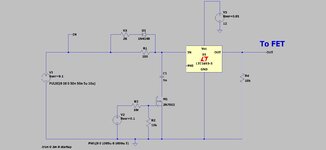cupoftea
Advanced Member level 6

Hi,
We all knew that Half Bridge shouldnt be done in Current Mode.
But with software to guide it, Current mode becomes possible.
You simply repeatedly measure the voltage on each of the series stacked capacitors....(by using two potential dividers)...and then you slightly adjust the alternate duty cycles to correspond to the voltages on the series stacked capacitors.....then the volt.seconds remain balanced in the transformer primary...and the series stacked capacitors stay with the same voltage.
Say the bottom capacitor starts getting increased voltage...then you very slightly increase the duty cycle of the bottom FET....until the capacitor voltages re-balance.
Simple!
Would you agree though?
Attached is how to do it..LTspice and jpeg
I believe now we will see the rejuvination of the Half Bridge in the SMPS world...do you agree?.....no more two transistor forward...with its awful 50% duty cycle limitation, and having to switch the full 400V PFC bus...whereas a half bridge transformer only has to switch half of it.
And No more awful push pulls..with its huge double_Vin FET voltage when OFF....and the awful primary leakage and magnetising energy to dissipate.
I mean, by all means...do all the duty cycle extension in software if you want....cycle by cycle.
We all knew that Half Bridge shouldnt be done in Current Mode.
But with software to guide it, Current mode becomes possible.
You simply repeatedly measure the voltage on each of the series stacked capacitors....(by using two potential dividers)...and then you slightly adjust the alternate duty cycles to correspond to the voltages on the series stacked capacitors.....then the volt.seconds remain balanced in the transformer primary...and the series stacked capacitors stay with the same voltage.
Say the bottom capacitor starts getting increased voltage...then you very slightly increase the duty cycle of the bottom FET....until the capacitor voltages re-balance.
Simple!
Would you agree though?
Attached is how to do it..LTspice and jpeg
--- Updated ---
I believe now we will see the rejuvination of the Half Bridge in the SMPS world...do you agree?.....no more two transistor forward...with its awful 50% duty cycle limitation, and having to switch the full 400V PFC bus...whereas a half bridge transformer only has to switch half of it.
--- Updated ---
And No more awful push pulls..with its huge double_Vin FET voltage when OFF....and the awful primary leakage and magnetising energy to dissipate.
--- Updated ---
I mean, by all means...do all the duty cycle extension in software if you want....cycle by cycle.
Attachments
Last edited:

